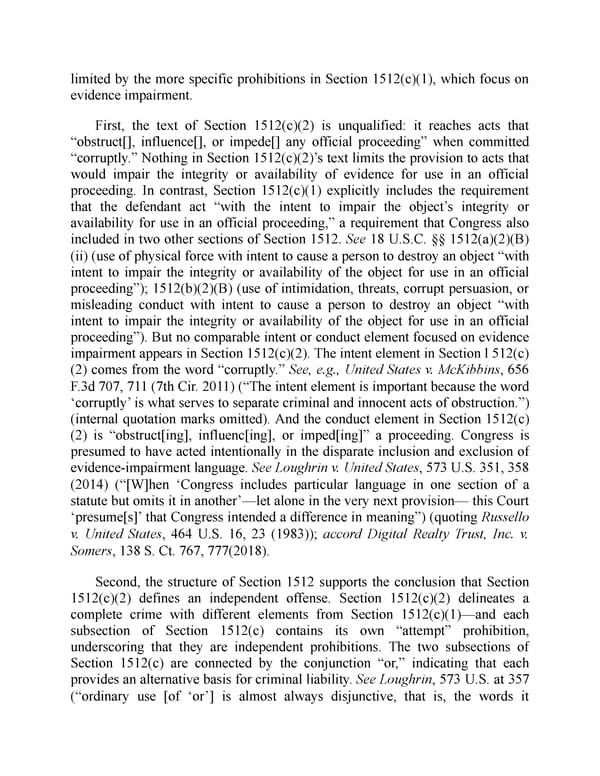limited by the more specific prohibitions in Section 1512(c)(1), which focus on evidence impairment. First, the text of Section 1512(c)(2) is unqualified: it reaches acts that “obstruct[], influence[], or impede[] any official proceeding” when committed “corruptly.” Nothing in Section 1512(c)(2)’s text limits the provision to acts that would impair the integrity or availability of evidence for use in an official proceeding. In contrast, Section 1512(c)(1) explicitly includes the requirement that the defendant act “with the intent to impair the object’s integrity or availability for use in an official proceeding,” a requirement that Congress also included in two other sections of Section 1512. See 18 U.S.C. §§ 1512(a)(2)(B) (ii) (use of physical force with intent to cause a person to destroy an object “with intent to impair the integrity or availability of the object for use in an official proceeding”); 1512(b)(2)(B) (use of intimidation, threats, corrupt persuasion, or misleading conduct with intent to cause a person to destroy an object “with intent to impair the integrity or availability of the object for use in an official proceeding”). But no comparable intent or conduct element focused on evidence impairment appears in Section 1512(c)(2). The intent element in Section l 512(c) (2) comes from the word “corruptly.” See, e.g., United States v. McKibbins, 656 F.3d 707, 711 (7th Cir. 2011) (“The intent element is important because the word ‘corruptly’ is what serves to separate criminal and innocent acts of obstruction.”) (internal quotation marks omitted). And the conduct element in Section 1512(c) (2) is “obstruct[ing], influenc[ing], or imped[ing]” a proceeding. Congress is presumed to have acted intentionally in the disparate inclusion and exclusion of evidence-impairment language. See Loughrin v. United States, 573 U.S. 351, 358 (2014) (“[W]hen ‘Congress includes particular language in one section of a statute but omits it in another’—let alone in the very next provision— this Court ‘presume[s]’ that Congress intended a difference in meaning”) (quoting Russello v. United States, 464 U.S. 16, 23 (1983)); accord Digital Realty Trust, Inc. v. Somers, 138 S. Ct. 767, 777(2018). Second, the structure of Section 1512 supports the conclusion that Section 1512(c)(2) defines an independent offense. Section 1512(c)(2) delineates a complete crime with different elements from Section 1512(c)(1)—and each subsection of Section 1512(c) contains its own “attempt” prohibition, underscoring that they are independent prohibitions. The two subsections of Section 1512(c) are connected by the conjunction “or,” indicating that each provides an alternative basis for criminal liability. See Loughrin, 573 U.S. at 357 (“ordinary use [of ‘or’] is almost always disjunctive, that is, the words it
 Mueller Report PDF Page 488 Page 490
Mueller Report PDF Page 488 Page 490